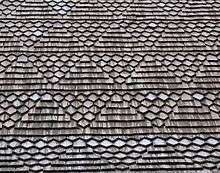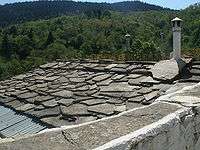Roof shingle
Roof shingles are a roof covering consisting of individual overlapping elements. These elements are typically flat, rectangular shapes laid in courses from the bottom edge of the roof up, with each successive course overlapping the joints below. Shingles are made of various materials such as wood, slate, flagstone, fibre cement, metal, plastic, and composite material such as asphalt shingles. Ceramic roof tiles, which still dominate in Europe and some parts of Asia, are still usually called tiles. Roof shingles are a very common roofing material in the United States, but may deteriorate faster and need to repel more water than wall shingles.
Etymology
Shingle is a corruption of German schindle (schindel) meaning a roofing slate.[1] Shingles historically were called tiles and shingle was a term applied to wood shingles,[1] as is still mostly the case outside the US.
Shingles are laid in courses usually with each shingle offset from its neighbors. The first course is the starter course and the last being a ridge course or ridge slates for a slate roof. The ridge is often being covered with a ridge cap, board, piece, or roll[2] sometimes with a special ridge vent material.
Overview
Roof shingles are almost always highly visible and so are an important aspect of a building's aesthetics in patterns, textures and colors. Roof shingles, like other building materials on vernacular buildings, are typically of a material locally available. The type of shingle is taken into account before construction because the material affects the roof pitch and construction method: Some shingles can be installed on lath where others need solid sheathing (sheeting) on the roof deck. All shingle roofs are installed from the bottom upward beginning with a starter course and the edge seams offset to avoid leaks. Many shingle installations benefit from being placed on top of an underlayment material such as asphalt felt paper to prevent leaks even from wind driven rain and snow and ice dams in cold climates. At the ridge the shingles on one side of the roof simply extend past the ridge or there is a ridge cap consisting of boards, copper, or lead sheeting. An asphalt shingle roof has flexible asphalt shingles as the ridge cap. Some roof shingles are non-combustable or have a better fire rating than others which influence their use, some building codes do not allow the use of shingles with less than a class-A fire rating to be used on some types of buildings. Due to increased fire hazard, wood shingles and organic-based asphalt shingles have become less common than fiberglass-based asphalt shingles. No shingles are water-tight so the minimum recommended roof pitch is 4:12 without additional underlayment materials.[3]
Roof shingles of Fitzroya came to be used as money and called "Real de Alerce".
Asphalt shingles
In the United States, fiberglass-based asphalt shingles are by far the most common roofing material used for residential roofing applications. In Europe they are called bitumen roof shingles or tile strips, and are much less common.[4] They are easy to install, relatively affordable, last 20 to 50 years and are recyclable in some areas. Asphalt shingles come in a large number of styles and colors.
The protective nature of paper and fiberglass asphalt shingles primarily comes from the long-chain petroleum hydrocarbons, while wood shingles are protected by natural oils in the cellulose structure. Over time in the hot sun, these oils soften and when rain falls the oils are gradually washed out of the shingles. During rain, more water is channeled along eaves and complex rooflines, and these are subsequently more prone to erosion than other areas.
Eventually the loss of the oils causes asphalt shingle fibers to shrink and wood shingles to rot, exposing the nail heads under the shingles. Once the nail heads are exposed, water running down the roof can seep into the building around the nail shank, resulting in rotting of underlying roof building materials and causing moisture damage to ceilings and paint inside.
Wood shingles

Two basic types of wood shingles are called shingles and shakes. The difference is in how they are made, the shingles are sawn and shakes are split. Wood shingles and shakes have long been known as a fire hazard and have been banned in various places, particularly in urban areas where exterior, combustible building materials contribute to devastating fires known as conflagrations.
The use of wooden roof shingles has existed in parts of the world with a long tradition of wooden buildings, especially Scandinavia, and Central and Eastern Europe. Nearly all the houses and buildings in colonial Chiloé were built with wood, and roof shingles were extensively employed in Chilota architecture.
Stone shingles
Slate shingles are also called slate tiles, the usual name outside the US. Slate roof shingles are relatively expensive to install but can last 80 to 400 years depending on the quality of the slate used, and how well they are maintained. The material itself does not deteriorate, and may be recycled from one building to another.
The primary means of failure in a slate roof is when individual slates lose their peg attachment and begin to slide out of place. This can open up small gaps above each slate. A secondary mode of failure is when the slates themselves begin to break up. The lower parts of a slate may break loose, giving a gap below a slate. Commonly the small and stressed area above the nail hole may fail, allowing the slate to slip as before. In the worst cases, a slate may simply break in half and be lost altogether. A common repair to slate roofs is to apply 'torching', a mortar fillet underneath the slates, attaching them to the battens.[1][3] This may applied as either a repair, to hold slipping slates, or pre-emptively on construction.
Where slates are particularly heavy, the roof may begin to split apart along the roof line. This usually follows rot developing and weakening the internal timbers, often as a result of poor ventilation within the roofspace. An important aspect to slate roofs is the use of a metal flashing which will last as long as the slates. Slate shingles may be cut in a variety of decorative patterns and are available in several colors.
Flagstone shingles are a traditional roofing material. Some stone shingles are fastened in place but some simply are held by gravity so the roof pitch cannot be too steep or the stones will slide off the roof. Sandstone has also been used to make shingles.
Gallery of stone shingles
.jpg) Slate roofers guild emblem as an ornament made with slate roof shingles, Meerbusch, Germany. Note the hip shingles act as a ridge cap.
Slate roofers guild emblem as an ornament made with slate roof shingles, Meerbusch, Germany. Note the hip shingles act as a ridge cap. A typical flagstone roof in Kastanitsa, Greece.
A typical flagstone roof in Kastanitsa, Greece. A dry laid stone roof in Switzerland
A dry laid stone roof in Switzerland
Fibre cement shingles
Fibre (fiber) cement shingles are often known by their manufacturer's name such as eternit or transite. Sometimes the fiber in the cement material was asbestos which has been banned for health reasons since the 1980s. Removal of asbestos shingles requires extra precautions and disposal methods.
Metal shingles
Metal shingles are extremely fire resistant, so are used in fire prone areas.

Plastic shingles
Plastic has been used to produce imitation slate shingles. These are lightweight and not fragile but combustible. Also, they are very lightweight and are one of the cheapest shingles to have installed.
See also
- Shingle style
- Roof cleaning
- Roof tiles, function similarly to shingles but they are called tiles
References
- 1 2 "Shingle" def. 1. Whitney, William Dwight, and Benjamin E. Smith. The Century dictionary and cyclopedia. vol 7. New York: Century Co., 1901. 5574. Print. Accessed 1/11/2014
- ↑ Passmore, Augustine C.. Handbook of technical terms used in architecture and building and their allied trades and subjects,. London: Scott, Greenwood, and Co.;, 1904. Print.
- ↑ Kang, Kaffee, and Rob Thallon. Graphic guide to frame construction. Student ed. Upper Saddle River, N.J.: Prentice Hall, 1998. 177. Print.
- ↑ "The Bitumen Roofing Industry – A Global Perspective: Production, Use, Properties, Specifications and Occupational Exposure" (PDF). ewa-europe.com. March 2011. Retrieved 22 October 2015.
| Wikimedia Commons has media related to Shingle roofs. |
